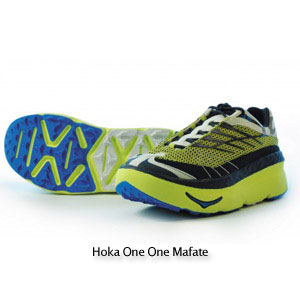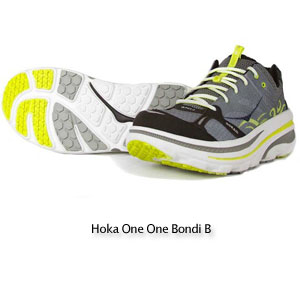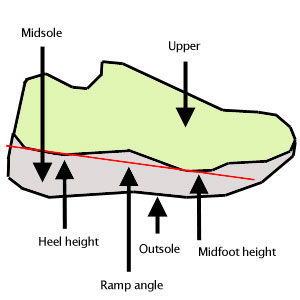Hoka One One Mafate

Slowtwitch readers might have read comments I've made about a curious looking shoe I've spent some time running in over the past few weeks. The shoe was not designed or marketed as a triathlon shoe. It's the darling of the ultra running set, specifically those who like to run on trails. The shoe brand is Hoka One One (all three words).
The shoe I'm writing about here is the Mafate, which is Hoka One One's long distance trail running shoe.
I've been running competitively for 40 years and if you amalgamate every comment from fellow runners I've ever gotten about the shoes I've run in over that span, they don't total the comments I've gotten while in this particular shoe. If you are self-conscious of remarks made about your person, avoid this shoe. Were I to attend a group workout in Bozo the Clown shoes; were I to toe the starting line of a footrace in swim fins; they would not elicit more stares and comments than I get while wearing these shoes.
I get asked—straight faced—if I'm wearing "contouring" shoes. "Yes," I say, "When I walk around the mall I can feel the fat sliding right off my thighs."
The point of these shoes is this: If you want your legs to feel as fresh at 8, or 15, or 22 miles into your run as they feel during the first few miles, you need to reduce the cumulative damage these miles inflict on your legs. Hoka One One Mafates were made specifically for the descents that are the bane of the ultra runner. The extra energy your thighs absorb with the decrease in elevation incurred during each downhill stride takes a tremendous toll in races of that length.
But as often happens in triathlon a saddle, a shifter, a brake lever, a piece of apparel, or a running shoe designed for another activity may work for our sport quite nicely. Hence my interest in this shoe; hence my decision to try it.
The typical response by someone who picks up this shoe is a raising of the eyebrow, because this shoe is a lot lighter than its mass would suggest. The Mafate's bulk below the upper must be close to double that of a Brooks Adrenaline (my erstwhile everyday trainer), yet my scale says the Mafate about equals the Adrenaline in weight (a tad under 11oz for a size-9 shoe in the 12oz neighborhood in my size-12 shoes).
The Mafate is buillt with features typically found in a neutral shoe, in that it has no technologies on its medial side that would suggest that medial structure is of interest to those who designed it. There is no higher density foam on the medial side, no post, no plate. That established, there are three things that conspire to make this shoe very workable for over-pronators.
First, it's a straight-lasted shoe, which is to say the arch of this shoe is not carved out in its mid- and outsole. Second, the shoe is board lasted, and I'm glad to see that this "older" technology has made its way back into shoes made by Hoka One One, Zoot and others, because if you use an orthotic (as I do) the platform in the shoe supports the orthotic squarely. Finally, this shoe's upper seats inside the molded midsole—the midsole cradles the upper, almost like a keyway.
This shoe is so supportive, in fact, during my first few runs there was uncommon pressure on my arch, because the shoe supported my orthotic so well. My first two or three runs were quite short—perhaps three miles. Were they any longer, I might have ended the run a blister under my arch, which is what happens when I run too long too soon on a new set of orthotics.
I have very dicey ankles, and always have had. Over my time as a runner I've turned my ankles hundreds of times, sometimes badly, sometimes not. My biggest concern was what would happen if and when I turned my ankle in this shoe. I still don't know the answer to that question. The good news is, the Mafate appears more stable than what I've been running in, even on trails (especially on trails). It's analogous to the problem I have with the tele ski rig I've been on since last year. My Rottefella NTN binding system mated to my Crispi boots seem to work great. Lots of stability, lots of support. But because I haven't fallen on them yet, I don't know for certain if they're going to release as they're supposed to. Until I turn these Mafates over, I won't know for certain whether the height of the Mafate is a problem, and I'm in no hurry to find out.
While it might seem counter-intuitive considering the size of the Mafate, this shoe fits best inside the category of "natural", if the major identifying feature of this category is a low "ramp angle" or ramp "delta" or midfoot drop or heel lift or whatever it is we'll eventually term this metric. Typical in a mid-weight trainer is about 12mm. In this shoe, it's 4mm. This is good news for midfoot strikers who want that more elongated calf-achilles complex at "bottom dead center" (pardon my borrowing from cycling's lexicon).
The Mafate also features what Hoka One One terms "rocker." You won't hear this term used much in technical running, because "rocker" has been kidnapped by footwear makers who sell the "mall shoes" mentioned above. One way to think of "rocker" is this: Wrap a piece of cellophane over the bottom of your Newtons. Fill in every space under the cellophane with Shoe Goo. Now there's a smooth transition from the heel, over the lug, to the forefoot. Both the filled-in shoe and the lugged version will feature a "hinge", or a "pivot", if you will. The Hoka has a contour reminiscent of this. Again, the idea is to accentuate forefoot striking and the push-off, post-strike.
A generation ago there a commercial on television made its way into popular culture. The advertisement was for Life cereal, and it featured three children at a kitchen table: two "older" buddies (maybe 8 years of age), and the younger, perhaps 4-year-old, brother of one named Mikey. Life cereal had been served in front of the two older boys, each dubious. A bowl was pushed in front of Mikey. "Let's let Mikey try it, he hates everything."
As regards running shoes, I'm Mikey. I hate everything. I can stroll into a technical running store, test drive 15 likely suspects, and hate them all, walking out empty handed. After my first 3-mile run in Mafates, I was dubious. I then ran twice in my Brooks, then took the Hokas out again, for another 3-mile run. Then again in my Adrenalines.
The Mafate is not a fast shoe, I don't think. Still, it's replaced Adrenalines as my everyday trainer. This, because of its structure, its stability, and my ability to run longer distances, on roads, without damage, and with less time in between such runs because of the softness of landing.
For me, this shoe is a revelation. I can't say it's going to remain my everyday trainer, because somebody is going to come along and make another shoe that features cushion and structure built into a low-offset platform.
This will not be my triathlon racing shoe. For that, you'll want to read my review of the Hoka Bondi B.
If I might anticipate two questions our readers will have. Hoka One One is pronounced, in the industry, just as you think it might be. However, its pronunciation was intended to be Hoka O-nay O-nay. Hoka in Maori means "fly" and O-nay O-nay (spelled One One) means "earth", hence, "fly over the earth." As to how this company's owners (ultradistance trail runners themselves) came about choosing an odd name from a distant land, I can relate.
Finally, where to buy? I have identified four retail store that ordered early and deep on Hoka One One shoes: Playmakers (Okemos, MI), Wasatch Running Center, Salt Lake Running Company, Boulder Running Company, and Super Runners Shop (NYC). Then there is the web store at Hoka One One.
One hopes that, eventually, triathlon's run-specific stores will also pick them up—in particular the Bondi B.




Start the discussion at slowtwitch.northend.network